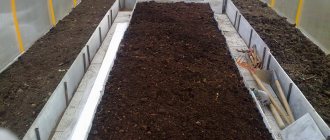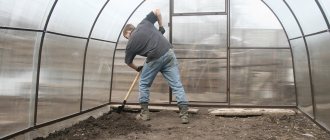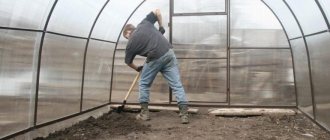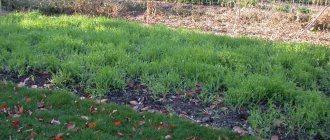The presence of a greenhouse on the site does not always mean fresh vegetables and a rich harvest. Abundant fruiting one or two seasons after installation is usually replaced by intense struggle with all kinds of pests and diseases. And the use of chemical insecticides during the growing season negatively affects the usefulness of the fruit.
This article will provide information on how to improve the soil in a greenhouse and raise fruiting to a higher level? Methods of exposure and preparations for disinfection and feeding. How to prepare the soil in a greenhouse for winter using chemical and natural methods?
Invalid Displayed Gallery
Preliminary preparation
Before preparing the soil in the greenhouse in the fall, it is necessary to carry out general cleaning, remove all remnants of plants and auxiliary materials (garter ropes and wooden pegs). The resulting garbage is a highly contaminated mass, so it is recommended to burn it rather than throw it into the compost heap.
Before disinfecting the soil in the greenhouse, it is necessary to disinfect the entire structure. Many of the pests hide in the cracks between the frame and glass or polycarbonate. It is these places that you should pay special attention to. The most effective preparations for disinfecting a greenhouse are a solution of potassium permanganate or copper sulfate. The concentration of both substances is taken approximately, but not less than 1 tablespoon per bucket of water for vitriol and 1 teaspoon for potassium permanganate. Particular attention should be paid to green mold that has formed on the bottom of the window material; it is best to scrape it off completely. The resulting solutions must be used to treat the frame and glass of the greenhouse. A solution of lime chloride is used to treat wooden structures.
Soil treatment
After cleaning, you can begin preparing the soil in the greenhouse for winter. This process can be divided into two parts: disinfection and soil fertilization. There are several ways to disinfect the soil:
- Chemical;
- Thermal;
- Biological.
In case of significant infestations by various pests, the simultaneous, combined use of several methods is practiced. Before disinfecting the soil in the greenhouse in the fall, it is necessary to determine the next crop that will be planted next spring for compatibility with the pesticides used. Some of them can inhibit the growth of cultivated plants or accumulate in food and, accordingly, enter the human body.
Chemical methods of disinfection
There are quite a few pests and diseases that can destroy standing crops. To effectively combat the most dangerous of them, special preparations have been developed. Which can be purchased at agricultural chemical and seed stores. However, most of them are used after the plants have been infected. To prevent the appearance of pests, preventive treatment of the soil in the greenhouse is carried out in the fall. It consists of watering the soil with a solution of formaldehyde or bleach. You can also fumigate the room with special sulfur or tobacco bombs. For greater effect, the room is sealed and intensively ventilated after 2-3 days.
Such methods are effective when cultivating soil in a greenhouse infected with late blight (late blight), spider mites, greenhouse whiteflies, various varieties of aphids, root and brown rot and some other less common diseases and pests. If the number of pests is insignificant, then treatment of the soil in the greenhouse with copper sulfate is carried out by spraying the surface with further digging of the top layer.
Thermal treatment methods
Temperature treatment of the soil in a polycarbonate greenhouse in the fall can be carried out in different ways. The simplest is to steam the soil with boiling water. Cool boiling water at the rate of 10 - 15 liters per 1 m2 is evenly distributed over the ground and then covered with film for several hours. Another fairly simple method is to calcinate the top layer of the earth using infrared lamps, which are often used in greenhouses as a heating system.
Steaming over a fire is used if it is necessary to disinfect a small amount of soil
A more labor-intensive and expensive method is internal ground calcination with hot steam. However, installing such a system will allow it to be used as an alternative earth heating system and significantly increase the growing season of plants. To apply this method, it is necessary to bury PVC pipes with a diameter of 60-80 mm in the soil of the greenhouse to a depth of 30-40 cm (from the top edge of the pipe to the surface of the ground).
Ground heating installation can be used for thermal disinfection
Holes are cut in the pipe along the entire length, through which during operation hot steam will escape, pumped by a heated vessel with water. It is better not to combine this type of treatment with ground electric heating, as short circuits are possible.
If the greenhouse is small and the amount of soil is small, then they practice calcining the soil on baking sheets placed over fires or laying them out directly on the cultivated land. This procedure can only be carried out if the stationary foundation of the greenhouse is high enough, and the material of the enclosing structures is glass and not polycarbonate.
Why do you need to clean the greenhouse in the fall?
What does a complete list of autumn work in the greenhouse include? There are not as many points as it seems, but there really is a lot of work to be done.
Autumn work in the greenhouse is:
- clearing the area of debris;
- thorough washing of the entire structure;
- greenhouse disinfection;
- soil fertilization;
- preparation for the winter period.
The list, as we see, includes several stages, and each of them must be completed. The fact is that only a well-maintained, cared-for greenhouse that is thoroughly cleaned of pests will delight you with a rich harvest every year. If you don’t take care of the structure and don’t worry about its cleanliness, then after a couple of years, even in a favorable region where frequent epidemics of plant diseases are not observed, parasites and pathogens can appear in the greenhouse. Soon they will multiply and fill the entire structure, damaging and destroying the plants living in it.
Autumn preparation of the greenhouse is a very important stage
So, to summarize, the greenhouse needs to be prepared in the fall because:
- in this case, in the spring it will not require preparatory work;
- during the autumn disinfection in the greenhouse, all parasites that managed to settle in it over the summer will be destroyed;
- the quality of the soil can be significantly improved by fertilizing it;
- when there are no more plants in the greenhouse, you can calmly fight various pests without fear for the harvest;
- the greenhouse will last much longer if you take care of it;
- Proper preparation will ensure a quiet winter for both the structure itself and you (you won’t have to worry that it will fall due to weather conditions).
Proper autumn preparation of the greenhouse will extend its service life
Now we will consider each stage of autumn preparation step by step.
Biological means of disinfection and recovery
Recently practiced by supporters of natural farming. The essence of this method is intensive crop rotation of fruit-bearing crops with green manure plants. This method is especially effective if the greenhouse has a heating system that can increase the growing season of plants in the fall from several weeks to 1.5-2 months. The advantages of planting green manure plants in the fall are obvious:
- Young plants provide more nitrogen that enters the ground while simultaneously “pulling” potassium salts to the surface with their root system;
- They do not need to be dug up, it is enough that in case of serious frosts they will die, forming a layer of humus on the surface, protecting the soil from being washed out in the fall and from sunburn in the spring;
Is it necessary to dig up the soil in the greenhouse in the fall after planting green manure? The land does not need reclamation; the dead root system not only fed it, but also became additional drainage.
Here's how to fertilize the soil in a greenhouse in the fall - mustard green manure plant is sown mainly before cucumbers
The following crops are widely used as green manure plants:
- Cereals – oats, rye, barley, wheat;
- Legumes – peas, lupine, phacelia, vetch;
- Cruciferous vegetables are also difficult - sunflower, radish, mustard.
Of all the listed plants, special attention should be paid to early-ripening and cold-resistant varieties: fodder peas, mustard, oats, vetch, rapeseed. They are the ones that are preferable to use as soil preparation for a greenhouse. The optimal growing season of 5-8 weeks is sufficient for the plants to gain maximum useful mass.
Strengthening the frame with special supports
Even the most vaunted industrial greenhouses, which are made of high-quality galvanized steel, sometimes still collapse under the snow. And the shocked owners then spend years trying to get their money back from the selling company, and not always successfully. It would seem, how can fragile snowflakes, even if there are many of them, bend a double structure, as in the “Kremlin” greenhouse? After all, these same arcs in the photo perfectly supported the weight of five or six men in the Mowgli pose... In fact, everything is simple, if you look from the point of view of physics - if you do not remove snow from the roof of the greenhouse all winter, then its pressure per meter can even reach a ton ! And Siberian snowfalls are especially treacherous in this regard. But the load-bearing capacity of the structure of even the most expensive greenhouses reaches 500 kg/m2 at best, and even 200 kg/m2 for ordinary ones. That’s why it won’t be superfluous, even in a calm winter, to strengthen the frame of the greenhouse in the fall - with special additional arches, if the manufacturer offers to purchase them, or with wooden supports in the shape of the letter “T”, made with your own hands. It is they who will support the ridge - the very top of the greenhouse.
For reference: the maximum load on any greenhouse is 30 cm of wet snow or 70 cm of fluffy snow. In total, the number of supports should be calculated as follows: 3-4 for a greenhouse six meters wide. But in those places where there is a general danger of snow caps forming (and this is near the fence and in leeward places), you need to install twice as many supports. And so that they do not fall or go deep into the ground, it is advisable to secure them to the top crossbar and put something solid under their base.
It is not necessary to treat good galvanized steel with special solutions in the fall - it is enough to either lubricate it with lime or paint only non-galvanized fittings - door handles, latches, hinges. But painted and unpainted greenhouses made of other materials will have to be given much more attention - they already need special treatment and painting to prevent natural corrosion.
But the film, no matter how durable it is, needs to be removed from the greenhouse for the winter - otherwise in frost it will become fragile and quickly turn into rags. And the wire frames on which the film was held must definitely be wiped with kerosene.
Using EM
EM - effective microorganisms. The use of EM when preparing soil in a greenhouse in the fall is mandatory after thermal disinfection of the soil. There are such preparations on sale as “Baikal”, “Vozrozhdenie”, “Shine”, they consist of beneficial soil microorganisms. Before cultivating the soil in the greenhouse in the fall with EAT preparations, it is necessary to add a sufficient amount of humus. Active reproduction begins at a temperature of 10-15 C. If the autumn is warm enough, then by spring the greenhouse will have completely restored soil.
Soil replacement
Replacing soil in a greenhouse in the fall is one of the radical and most effective ways to increase productivity. Replace them if the infestation is too strong and is caused by several pests at once. In this case, it is necessary to select soil to a depth of 10-15 cm. This will result in a fairly large volume of contaminated soil. Where to put the land if there is not enough space on the site for disposal? You can not only disinfect it, but also use it for exchange after a year. To do this, the resulting soil is placed in a pile of arbitrary width, in layers 20 cm thick. Each layer is sprinkled with quicklime at the rate of 100 - 150 g. per sq. m.
Using peat as a basis for new soil in a greenhouse
The composition of the soil that must be laid to replace the withdrawn soil in a ratio of 6.5:1:1:
- Peat – sphagnum, without fertilizers, crumbly;
- The soil is fine-grained sandy loam or light loam with added humus;
- Compost - can be replaced with chicken manure at the rate of 5 kg per 1 cubic meter.
There are natural, biological additives that are highly recommended to be used in the soil, instead of inorganic fertilizers, at least in the first 2 years of use:
Some tips from the professionals
Simultaneously with soil disinfection, the entire structure is usually disinfected in the fall. The sulfur bombs used for this cannot be used in greenhouses with a metal frame, since the smoke from the sulfur bomb will cause severe corrosion of iron structures.
Green manure planted after harvesting does not have to be removed. If they have grown high enough, they need to be mowed and left in the beds, and in the spring simply incorporated into the soil while digging.
In small structures, treatment can be done using potassium permanganate. To do this, you need to prepare a 2% solution, which is poured onto the dug up soil.
To make the greenhouse soil light and loose, river sand is added to it (about 1/6). This prevents the fertile layer from being washed away.
If you use the method of freezing the soil, you can cover the beds with snow at the end of winter or at the beginning of spring. Fresh melt water will have a beneficial effect.











